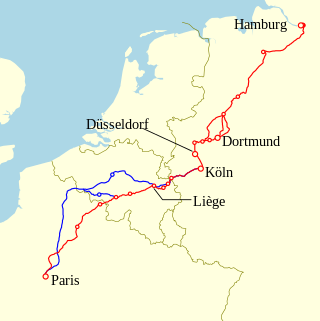
The Blauer Enzian is a named express train service that currently runs between Frankfurt in Germany and Klagenfurt in Austria. Introduced in 1951, it originally ran via the German North–South railway line between Hamburg and Munich. Labelled as an international Trans Europ Express (TEE) train, it also linked with Zell am See and Klagenfurt in Austria from 1969. Trains were operated by the Deutsche Bundesbahn (DB) and its Deutsche Bahn successor, from 1970 also by the Austrian Federal Railways (ÖBB).
The Diamant was an express train operated by the Deutsche Bundesbahn (DB), using different routes over the years. The name Diamant, Dutch for diamond, refers to the city of Antwerp, which is the European centre of diamond trade and has a diamond district. The initial service started in 1962 as a first-class-only FernTriebwagen linking the West-German capital Bonn with Antwerp, using a class DB Class VT 08 diesel multiple unit (DMU).

L'Oiseau Bleu was an international express train linking Antwerp with Paris. The train was named after the play L'Oiseau Bleu as a tribute to its author, the Belgian Nobel prize laureate Maurice Maeterlinck.
The Memling was an express train that linked Gare du Nord in Paris, France, with Brussel Zuid in Brussels, Belgium. The train was named after German painter Hans Memling.
The Rubens was an express train that linked Gare du Nord in Paris, France, with Bruxelles-Midi / Brussel-Zuid in Brussels, Belgium. The train was named after Flemish painter Peter Paul Rubens.

The Watteau was an express train that linked Gare du Nord in Paris, France, with Tourcoing in the North of France. The train was named after the French painter Antoine Watteau.
The Gayant was an express train that linked Gare du Nord in Paris, France, with Tourcoing in the department of Nord, also in France. The train was named after Gayant, the processional giant of Douai, France.

The Rhein–Main was an express train that linked Frankfurt am Main with Dortmund in Germany and later with Amsterdam in the Netherlands. The train was named after the two rivers, the Rhine and the Main, that join west of Frankfurt. For most of its life, it was a Trans Europ Express (TEE).

The Rembrandt was an express train that linked Amsterdam in the Netherlands, with Munich in Germany and later Chur in Switzerland. The train was named after the renowned Dutch painter Rembrandt. For its first 16 years it was a first-class-only Trans Europ Express, becoming a two-class InterCity in 1983 and finally a EuroCity in 1987.

The Parsifal was an express train that linked Paris with Dortmund in Germany and later Cologne. The train was named after Wagner's opera inspired by the legendary knight Percival.

The Erasmus was an express train that linked The Hague, the Dutch seat of government, with Munich in Germany. The train was named for the Dutch Renaissance humanist Desiderius Erasmus.
The Bacchus was an express train in Germany, initially linking Dortmund and Munich. The train was named after the Roman God of wine, although for most of its existence it linked two cities famous for producing beer.
The Friedrich Schiller was an express train in Germany, initially linking Düsseldorf and Stuttgart. The train was named after the philosopher and playwright Friedrich Schiller.

The Vesuvio was an express train in Italy, linking Milan and Naples. The train was named after Mount Vesuvius the volcano near Naples.
The Heinrich Heine was an express train operated by Deutsche Bundesbahn, initially linking Frankfurt am Main and Dortmund. The train was named after the German poet and journalist Heinrich Heine.

The Adriatico was an express train operated by Ferrovie dello Stato, linking Milan and Bari. It was named for the Adriatic Sea, Mare Adriatico in Italian, as the train's route served the main cities along the shore of the Adriatic between Rimini and Bari.

The Cycnus was an express train operated by Ferrovie dello Stato, linking Milan with Ventimiglia, Italy. Cycnus literally means swan, but more likely the name refers to the mythological King of Liguria, the region the train served.

The Molière was an international train operated by SNCF, initially linking Paris and Düsseldorf. The train was named after Jean Baptiste Poquelin, using his stage name.

The Van Beethoven was an international train linking the Dutch capital Amsterdam and the West German capital Bonn. The train was named after the Bonn-born composer Ludwig van Beethoven.

The Colosseum was an express train initially linking Rome and Milan, later Frankfurt am Main. The train was named after the Amphitheatrum Flavium, renowned as the Colosseum.













